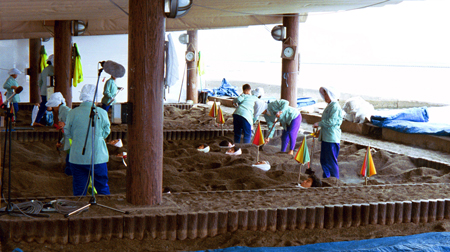Ibusuki Onsen on:
[Wikipedia]
[Google]
[Amazon]

 is a group of
is a group of
Ibusuki tourism net
{{in lang, en Ibusuki, Kagoshima Hot springs of Japan Spa towns in Japan Tourist attractions in Kagoshima Prefecture Landforms of Kagoshima Prefecture

 is a group of
is a group of hot spring
A hot spring, hydrothermal spring, or geothermal spring is a spring produced by the emergence of geothermally heated groundwater onto the surface of the Earth. The groundwater is heated either by shallow bodies of magma (molten rock) or by circ ...
s in the east of Ibusuki, Kagoshima
is a city located in Kagoshima Prefecture, Japan, founded on April 1, 1954. In March 1, 2012, the city had an estimated population of 43,931, with 19,119 households and a population density of 294.82 persons per km2. However the census of 2020 c ...
in Japan, which includes Surigahama Onsen, Yajigayu Onsen, and Nigatsuden Onsen.
2,850,000 people visited in 2003, and 910,000 people stayed there.
90% of the water is used for industry.
Access
It takes about an hour fromKagoshima-Chūō Station
is a major railway station in Kagoshima, Japan, operated by Kyushu Railway Company (JR Kyushu). It is the main railway terminal serving Kagoshima, the southern terminus of the Kyushu Shinkansen and is located on the Kagoshima Main Line and Ibusuk ...
by train, and about one hour and thirty-five minutes by non-stop bus.
Water quality
There are about 500 places operating as spring sources. The total amount discharged is about 120,000 tonnes per day. The water contains mostlysodium
Sodium is a chemical element with the symbol Na (from Latin ''natrium'') and atomic number 11. It is a soft, silvery-white, highly reactive metal. Sodium is an alkali metal, being in group 1 of the periodic table. Its only stable iso ...
. It is a chloride spring but the concentration of salt and minor components differ by region or depth of excavation.
The temperature of discharge is about 50 to 60 degrees, but there is one which is near 100 degrees.
The source of water is a mixture of rain water from Ikeda Lake and Unagi Pond and sea water from Kagoshima Bay.
History
From about 1919 to 1955, the amounts of hot water taken rose to use the heat inagriculture
Agriculture or farming is the practice of cultivating plants and livestock. Agriculture was the key development in the rise of sedentary human civilization, whereby farming of domesticated species created food surpluses that enabled people to ...
and salt production
Salt is a mineral composed primarily of sodium chloride (NaCl), a chemical compound belonging to the larger class of salts; salt in the form of a natural crystalline mineral is known as rock salt or halite. Salt is present in vast quantitie ...
. Many problems happened; for example, the depletion of the old source of the springs and a decrease in temperature. Because of this, a new source of hot springs was searched for and in 1957, a new layer of hot springs was found in 200 to 300 m below ground and was started for use.
Since 1964 using hot springs for salt production has been banned; however, using them for agriculture and aqua farming of fish has continued.
Other hot springs
Yajigayu Onsen
Yajigayu Onsen is north of Ibusuki Station. It is said that its name is derived from that of Yaji who discovered this hot spring. Yajigayu Onsen is used in the cultivation of household foliage plants.Nigatsuden Onsen
Nigatsuden Onsen is weak acid and it is west of Nigatsuden Station. In 1831, Narioki Shimadzu, lord of Kagoshima, moved his manor house from Surigahama and this hot spring was called the Lord’s Hot Spring (Tonosama-yu).Surigahama Onsen
Surigahama Onsen is at a road along the coast southeast of Ibusuki Station. It is said that its name is derived from this place was called Sunabagahama.(lit. beach of sand pool)Suna-mushi Sand Hot Spring
Suna-mushi is a kind of bathing. First bathers put on ayukata
A is an unlined cotton summer kimono, worn in casual settings such as summer festivals and to nearby bathhouses. Originally worn as bathrobes, their modern use is much broader, and are a common sight in Japan during summer. Though are tradition ...
. They are covered with sand and steamed by sands, which is agitated to be a moderate temperature. It is difficult to bath alone, so staff are on hand to shovel sand over bathers. Draping a towel around the head is advised to keep sand from sticking to it.
Since 1982, the city has held the annual Ibusuki Onsen Marathon (after 1984, the name was changed to Ibusuki Nanohana Marathon) on the second Sunday of January and more than 10,000 people take part in it every year.
References
* Ibusuki City Hall. Office Administration Division. City Guide Magazine. Mayor Higo Norimasa, 1985, * Ibusuki City Guide (Journal version). Mayor Tahara Sako, 2005, * Kurokawa Susumu (Paperback) Kagoshima. Spring Garden Church Publishing, 1997, ,External links
Ibusuki tourism net
{{in lang, en Ibusuki, Kagoshima Hot springs of Japan Spa towns in Japan Tourist attractions in Kagoshima Prefecture Landforms of Kagoshima Prefecture